A report on Upanishad Ganga based Lecture Series II conducted from 22nd to 25th December 2014 at Ahmedabad Management Association. (AMA)
 To gear-up for Pujya Gurudev’s Birth Centenary year celebrations, under the guidance of Br. Atharvana Chaitanya the third phase of the series of talks based on “Upanishad Ganga” was organised at AMA as a humble offering to Pujya Gurudev.
To gear-up for Pujya Gurudev’s Birth Centenary year celebrations, under the guidance of Br. Atharvana Chaitanya the third phase of the series of talks based on “Upanishad Ganga” was organised at AMA as a humble offering to Pujya Gurudev.
The four days lecture series focusing on the four Ashramas of human life comprised of 90 minutes sessions wherein everyday the auditorium was filled with over 160 enthusiastic students of all age groups. After a short talk highlighting the scriptural viewpoint on the topic of the day, the relevant episodes of “Upanishad Ganga” were screened. This was followed by a short discussion and a question-answer session. The titles for the talks and a brief summary of the content thereof are as follows:
1) Student Life Aspiration (Brahmacharya Ashram):
A brahmachari is the one who is focused on his endeavour of gaining knowledge and reaching the supreme Truth He is the one who conserves energy and channelizes it towards gaining knowledge. Br. Atharvana Chaitanyaji explained that surrender, clarity of thought, self discipline, purposeful self-denial, faith and service are the cornerstones of life of a student. During this phase of student-life the only duty one has to perform is to obey one’s Guru. In this phase of life, with total commitment to obey his Guru the student forgoes his own likes and dislikes. The touching story of Jabala’s son Satyakam mesmerized the audience and indicated the importance of thinking and questions in our life. This story lucidly conveyed that a Guru always comes to a sincere student who has within a desire to know irrespective of his caste, creed or culture. It highlighted that a burning desire to gain knowledge is the only requirement to qualify as a student.
2) Household Duties (Grihastha Ashrama)
A Grihastha (householder) is the one who holds the house together and not the one who is held by the house. It is said that “ चतुर्णामाश्रमाणां हि गार्हस्थ्यं श्रेष्ठमाश्रमम्।’’ Out of the four ashramas, it is only in grihastha ashrama that one has the privilege to attain the goals (Purusharthas) such ‘Artha”, and ‘Kama’ therefore it is considered to be the most interesting ashrama of the four ashrams of human life. Quoting the commentary of Sri Adi Shankaracharyaji on Prashnopanishad, Br. Atharvana Chaitanyaji very beautifully explained certain seemingly negative but inevitable facets of Grihastha ashrama to be able to deal with the society in an unruffled and effective manner. However he also highlighted that with these privileges, come the duties of a Grihastha which are to walk the path of karma yoga i.e performance of one’s duties as offerings unto the Lord and accepting the results with Prasadbuddhi and at the same time serve the society with a clear understanding of one’s role in the society. Everyone could relate to the entertaining episode based on “Mahakavi Maagha”, in which, the character “Siddharthak” was loved by all.
3) The Art of Retirement (Vanaprastha Ashrama)
This is an important stage in life where, from being a limited entity of a householder, with a strong sense of ownership we choose to move on to the next stage of life, which is -Vanaprasta. This comes from the words, Vana (forest) and Prasthaan (to go), which means to walk out of our limited identification of “my home” and “my family”, and expand by embracing the whole world as my home. Br. Atharvanaji explained it through a beautiful analogy of a caterpillar. The caterpillar, in the larva stage, keeps eating until it reaches the pupa stage. Eating (in the larva stage) here refers to the Grihastha stage where one builds wealth, knowledge, relationships etc. Having eaten enough, the larva becomes a pupa and finds a peaceful place, & starts weaving a cocoon around itself. This stage is the Vanprastha ashram. Where, having fulfilled all the responsibilities, one hands them over to the younger generation. Time is then spent on diving deep into the inquiry of the Self. Thus when we give up all attachments we make our own homes a “Tapovanam” (forest of austerities) and live in peace, seeking nothing but the higher. The episode on “King Dhritarashtra” and the King of Magadha “Bimbisar” brought out very well the sorrow faced by the one who is unable to free himself from the worldly attachments.
4) Winning in the game of Life (Sanyaas Ashrama)
Br. Atharvana Chaitanya explained that the last and ultimate Ashram of Human life Sanyaas is the act of giving up well. Then the question comes what is to be given up? It is the act of giving up one’s attachments towards the worldly objects and one’s own ego. Continuing the analogy of the caterpillar, Brahmachari ji said, the final transformation of the caterpillar into a beautiful butterfly is Sanyasa – where, the whole world becomes your family (Vasudhaiva Kutumbakam) and Sky is the limit to achieve anything. However, it is not merely a physical act of refraining from objects, but it is a state of maturity where one renounces the lower to pursue the Higher (The Supreme). It is the renunciation of the doer-ship and enjoyer-ship and being established in the Truth. Such a state is attained through purity of mind, clarity of knowledge and maturity in detachment. Two episodes of Upanishad Ganga were screened; one each based on the patriotic sanyaasi Shri Vidyaaranya Swami and the realised sage Yaajnavalkya.

